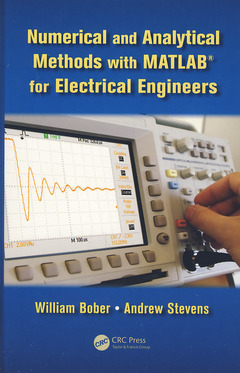Description
Numerical and Analytical Methods with MATLAB for Electrical Engineers
Applied and Computational Mechanics Series
Authors: Bober William, Stevens Andrew
Language: English
Subjects for Numerical and Analytical Methods with MATLAB for...:
Keywords
RLC Circuit; Parallel RLC Circuit; Electrical Engineering; Series RLC Circuit; Computer Engineering; MATLAB’s Fmincon Function; MATLAB; MATLAB’s Ode45 Function; Numerical Methods; MOS Transistor; Tri-diagonal System; LC RC; Modified Euler Method; Fzero Function; PN Junction; Runge Kutta Method; Advanced Engineering Mathematics; Laplace Transform; Fir Filter; Fcn Block; Command Window; Pivot Row; Euler Method; MATLAB’s Interp1 Function; Multiply Row; MATLAB’s Fmincon; Root Lies; Script Window; RC Circuit
368 p. · 15.6x23.4 cm · Hardback
Description
/li>Contents
/li>Readership
/li>Biography
/li>
Combining academic and practical approaches to this important topic, Numerical and Analytical Methods with MATLAB® for Electrical Engineers is the ideal resource for electrical and computer engineering students. Based on a previous edition that was geared toward mechanical engineering students, this book expands many of the concepts presented in that book and replaces the original projects with new ones intended specifically for electrical engineering students.
This book includes:
- An introduction to the MATLAB programming environment
- Mathematical techniques for matrix algebra, root finding, integration, and differential equations
- More advanced topics, including transform methods, signal processing, curve fitting, and optimization
- An introduction to the MATLAB graphical design environment, Simulink
Exploring the numerical methods that electrical engineers use for design analysis and testing, this book comprises standalone chapters outlining a course that also introduces students to computational methods and programming skills, using MATLAB as the programming environment. Helping engineering students to develop a feel for structural programming?not just button-pushing with a software program?the illustrative examples and extensive assignments in this resource enable them to develop the necessary skills and then apply them to practical electrical engineering problems and cases.
Numerical Methods for Electrical Engineers. MATLAB® Fundamentals. Matrices. Roots of Algebraic and Transcendental Equations. Numerical Integration. Numerical Integration of Ordinary Differential Equations. Laplace Transforms. Fourier Transforms and Signal Processing. Curve Fitting. Optimization. Simulink. Appendices. MATLAB® Function Index.
Dr. William Bober received his B.S. degree in civil engineering from the City College of New York (CCNY), his M.S. degree in engineering science from Pratt Institute, and his Ph.D. degree in engineering science and aerospace engineering from Purdue University. At Purdue University, he was on a Ford Foundation Fellowship; he was assigned to teach one engineering course each semester. After receiving his Ph.D., he went to work as an associate engineering physicist in the Applied Mechanics Department at Cornell Aeronautical Laboratory in Buffalo, New York. After leaving Cornell Labs, he was employed as an associate professor in the Department of Mechanical Engineering at the Rochester Institute of Technology (RIT) for the following twelve years. After leaving RIT, he obtained employment at Florida Atlantic University (FAU) in the Department of Mechanical Engineering. More recently, he transferred to the Department of Civil Engineering at FAU.
Dr. Andrew Stevens, P.E., received his bachelor’s degree from Massachusetts Institute of Technology, his master’s degree from the University of Pennsylvania, and his doctorate from Columbia University, all in electrical engineering. He did his Ph.D. thesis work at IBM Research in the area of integrated circuit design for high-speed optical networks. While at Columbia, he lectured a course in the core undergraduate curriculum and won the IEEE Solid-State Circuits Fellowship. He has held R&D positions at AT&T Bell Laboratories in the development of T-carrier multiplexer systems and at Argonne National Laboratory in the design of radiation-hardened integrated circuits for colliding beam detectors. Since 2001, he has been president of Electrical Science, an engineering consulting firm specializing in electrical hardware and software.




